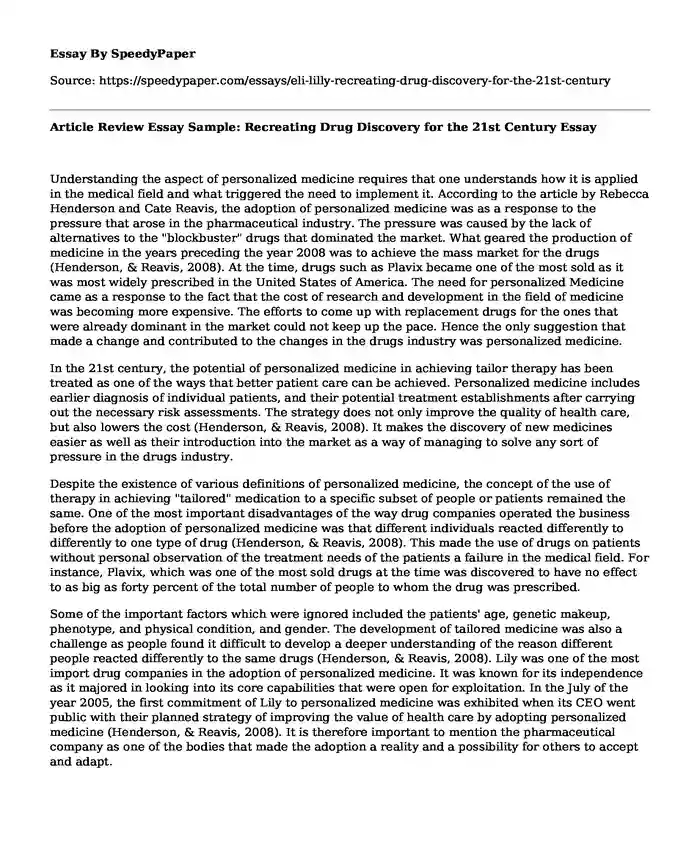
| Type of paper: | Essay |
| Categories: | Medicine Pharmacology |
| Pages: | 3 |
| Wordcount: | 600 words |
Understanding the aspect of personalized medicine requires that one understands how it is applied in the medical field and what triggered the need to implement it. According to the article by Rebecca Henderson and Cate Reavis, the adoption of personalized medicine was as a response to the pressure that arose in the pharmaceutical industry. The pressure was caused by the lack of alternatives to the "blockbuster" drugs that dominated the market. What geared the production of medicine in the years preceding the year 2008 was to achieve the mass market for the drugs (Henderson, & Reavis, 2008). At the time, drugs such as Plavix became one of the most sold as it was most widely prescribed in the United States of America. The need for personalized Medicine came as a response to the fact that the cost of research and development in the field of medicine was becoming more expensive. The efforts to come up with replacement drugs for the ones that were already dominant in the market could not keep up the pace. Hence the only suggestion that made a change and contributed to the changes in the drugs industry was personalized medicine.
In the 21st century, the potential of personalized medicine in achieving tailor therapy has been treated as one of the ways that better patient care can be achieved. Personalized medicine includes earlier diagnosis of individual patients, and their potential treatment establishments after carrying out the necessary risk assessments. The strategy does not only improve the quality of health care, but also lowers the cost (Henderson, & Reavis, 2008). It makes the discovery of new medicines easier as well as their introduction into the market as a way of managing to solve any sort of pressure in the drugs industry.
Despite the existence of various definitions of personalized medicine, the concept of the use of therapy in achieving "tailored" medication to a specific subset of people or patients remained the same. One of the most important disadvantages of the way drug companies operated the business before the adoption of personalized medicine was that different individuals reacted differently to differently to one type of drug (Henderson, & Reavis, 2008). This made the use of drugs on patients without personal observation of the treatment needs of the patients a failure in the medical field. For instance, Plavix, which was one of the most sold drugs at the time was discovered to have no effect to as big as forty percent of the total number of people to whom the drug was prescribed.
Some of the important factors which were ignored included the patients' age, genetic makeup, phenotype, and physical condition, and gender. The development of tailored medicine was also a challenge as people found it difficult to develop a deeper understanding of the reason different people reacted differently to the same drugs (Henderson, & Reavis, 2008). Lily was one of the most import drug companies in the adoption of personalized medicine. It was known for its independence as it majored in looking into its core capabilities that were open for exploitation. In the July of the year 2005, the first commitment of Lily to personalized medicine was exhibited when its CEO went public with their planned strategy of improving the value of health care by adopting personalized medicine (Henderson, & Reavis, 2008). It is therefore important to mention the pharmaceutical company as one of the bodies that made the adoption a reality and a possibility for others to accept and adapt.
Reference
Henderson, R., & Reavis, C. (2008). Eli Lilly: Recreating Drug Discovery for the 21 st Century. Case study, Massachusetts Institute of Technology (MIT), Cambridge (Massachusetts), 13.
Cite this page
Article Review Essay Sample: Recreating Drug Discovery for the 21st Century. (2022, Sep 21). Retrieved from https://speedypaper.net/essays/eli-lilly-recreating-drug-discovery-for-the-21st-century
Request Removal
If you are the original author of this essay and no longer wish to have it published on the SpeedyPaper website, please click below to request its removal:
- Essay Example Describing the Impact of Globalization on Income Inequality
- Free Essay on Change Management and Leadership
- Freedom of Speech Limits - Argumentative Essay Example
- Essay Sample: Advantages and Disadvantages of the Electoral College
- Free Essay Explaining How Punctuality and Attendance Relates to Character
- The Passion of the Christ - Movie Review Essay Sample
- Essay Sample about Persuasion in English
Popular categories




